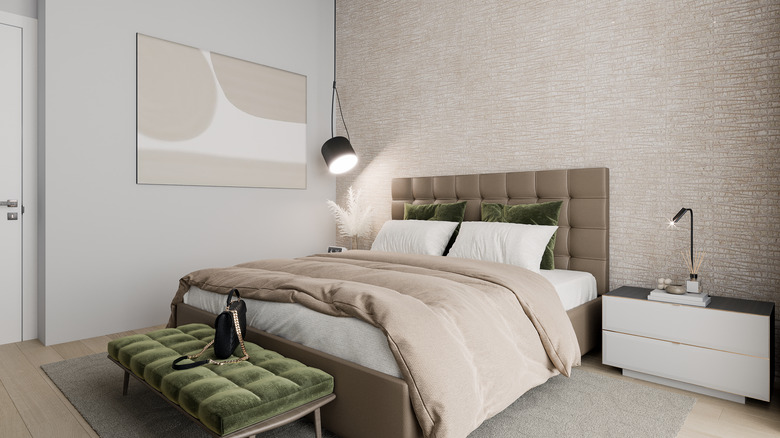HGTV's Property Brothers Show Us The Perfect Way To Mix Textures In The Bedroom
For a room to be visually interesting, it needs a variety of textures. Texture prevents the room from looking flat and one note. HGTV's Drew and Jonathan Scott recently shared a bedroom on Instagram that they designed for clients, featuring a variety of textures. "Mixing textures is key!" according to Drew & Jonathan. "So many rooms can feel dull by sticking with one pattern or texture throughout. But here, we see fuzzy faux fur in the throw blanket, sturdy woodgrains in the nightstand, and even playful patterns in the rug. (We're also obsessed with the accent wall. It's so simple to add interest with wallpaper!)" The soft fur and hardy wood contrast one another, not only in texture but also in color. The printed rug underneath the bed is plush but still grounding. The balance of hard and soft textures is the perfect mix and keeps the eyes bouncing around the room.
Not only do you want to consider the texture itself, but also the scale and amount. In the bedroom the Scotts designed, there is a balance between harder surfaces, such as the nightstands, mirror, and bench at the foot of the bed and softer pieces, such as the pillows, curtains, and accent chair. Even the bed has distinct textures despite being overwhelmingly soft. The pillows have varying patterns and are made of different materials than the comforter. The variety creates visual interest on both a large and small scale.
Making texture work
Jonathan and Drew Scott prefer to use a variety of textures and patterns to make a bedroom's design more interesting. However, using a variety of textures in one space can be tricky, as you often have to strike a balance between all the elements. When mixing textures, you don't want them to clash or be too visually stimulating. One way to avoid this is by having a connecting thread, figuratively, through each element. This is commonly done with a color scheme running through the entire space.
Choosing a palette of three to five colors will ensure that the room's design remains cohesive. Similarly, you can visually add texture with different patterns and art. Wallpaper is one of the best ways to add patterns to a room. Similarly, art and the frames around it can bring texture into the room.
"One of the biggest trends is mixed metals, but also mixing many materials to make for more interesting designs," Jonathan Scott says in an interview with Native Trails. Consider what materials are used in small decorative vignettes and throughout the room. Mix materials, using a variety of fabrics for pillows and blankets on a bed, layering curtains over blinds on windows, or adding a lamp with a smooth finish on top of a wood dresser or nightstand. Working in smaller groups can make adding texture throughout the bedroom more manageable.

